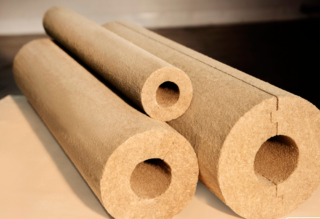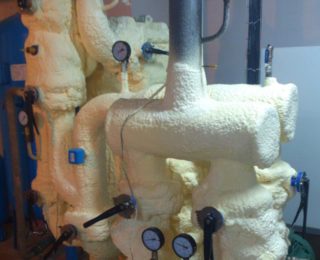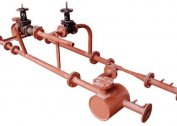In cold climates, sometimes it happens that during the night the water in the pipes freezes and it is impossible to get it from there for domestic needs. In this case, it is necessary to arrange thermal insulation for water pipes. There are several ways, depending on the type and material of the insulation.
Reasons for insulation of water pipes

All materials are subject to expansion, the degree of which differs for plastic and metal. When ice forms inside, it can break both steel and plastic. As a result, the water in the house will not even be in the thaw, since it will all leak into the crack.
To repair a broken water pipe, a crack must first be found. It doesn’t matter what distance is from the well to the house - you have to dig the entire trunk. Then you need to replace the site - buy a piece of pipe from a suitable material, invite the master with welding to do all the work. After that, bury the pipe back. It is good if the situation does not happen again next year, but while the pipe is in an open state after an emergency excavation, it is advisable to insulate it and forget about the accident.
The lower the pipe is located in the ground, the less likely it is to freeze. If an accident occurs, then the water supply is located in the freezing zone of the soil. It is necessary to warm it.
Warming Methods
It is not always possible to lay pipes deeply, due to the characteristics of the soil. For example, groundwater may come too close to the surface of the earth or the bottom layer is a solid stone. It is worth considering alternative ways to avoid an accident.
Pressure increase in the water supply system
In order for water to enter the house faster and not stay in the pipe, you can increase the pressure of the pump located in the well. After the pump, a check valve is installed, which prevents the pressure from dropping after shutdown. In this case, submersible units with a higher pressure work best.
Cable for heating a water pipe
For the winter period, a heating cable is also suitable, which is laid in a pipe or on top of it. A power of 10 - 20 W is enough so that the liquid inside does not freeze. These are economical systems that can be turned on at low temperatures. It is possible to connect a temperature sensor that will automatically turn on the heating if frost hits at night.
The cable is connected complete with insulation materials or as the only way to heat pipes.
Thermal insulation for water pipes
An inexpensive way is to insulate underground utilities with various insulating materials that retain heat and do not allow cold. These include:
- Styrofoam;
- polystyrene foam;
- penoplex;
- rock mineral wool;
- glass wool.
Materials may have a solid structure or sold in rolls. For example, high-density stone wool has the appearance of a pipe that has been cut from two sides for ease of installation. After installing the frame on the pipe, the two halves are fastened with tape.
For underground work, all heaters must be hydrophobic (not absorbing moisture). If pipes are located above the surface of the earth, such sections must be insulated with a thicker layer.
Materials for pipe insulation
Heaters for water pipes can be selected by degree of rigidity, price, moisture resistance and durability. Rigid materials last longer and do not undergo aggressive environmental influences: they do not absorb water, they do not grow moldy, and do not lose their shape under extreme temperatures.
Hard insulation
Hard heaters include:
- Basalt mineral wool is a substance that is obtained by melt of volcanic rocks, which are converted into long fibers on special equipment and pressed into slabs. This material is not afraid of moisture if it is additionally treated with water-repellent agents. Bacteria do not damage the mineral wool, so its service life reaches 50 years in aggressive conditions. For pipe insulation, it is produced in the form of a shell, which during installation is fastened with adhesive tape.
- Penoplex or extruded polystyrene foam. The material is expensive, since the service life, as well as the characteristics of thermal conductivity, hygroscopicity, and zero vapor permeability, make it possible to once and for all solve the problem of pipe insulation in the ground. Penoplex resists compression loads well, therefore it is suitable for use in soil, where there may be natural shifts and violation of the integrity of the coating and pipes. It is a synthetic material and therefore does not rot. For pipes, it is produced in the form of two halves, between which a water main is laid, but you can also use plates by making a box out of them.
- Polyfoam is a less expensive material, but meets all the requirements of thermal conductivity, and also does not absorb moisture. Foam insulation of a water supply system is possible in two ways - arrangement of a box or shell along the diameter of the pipe.
When choosing a hard insulation, it is necessary to take into account where the water supply is located - in the soil or on the surface, in order to choose a UV-resistant material, such as stone wool, since polystyrene and foam are destroyed by sunlight.
Roll insulation
Among the roll insulation for a water supply pipe, you can use:
- Penofol foil. Foamed polyethylene has good thermal conductivity and vapor tightness. A feature of the material is that it is laid on pipes on top of another, for example, glass wool.
- Glass wool for pipes must be bought with a hydrophobic coating so that it does not absorb moisture and does not lose its properties. If the pipes are metal, moisture can cause rust. Masters do not recommend laying only glass wool, you need to wrap it with another layer, which leads to a rise in the cost of the water supply.
- Stone wool in rolls. Insulated pipes for water supply with this natural material do not form condensate and maintain a constant temperature inside.
- Synthetic rubber - can be used to insulate underground water pipes for wrapping pipes. The seams are closed tightly with a blowtorch so that water cannot penetrate inside. Open areas in the sun do not wrap this material, as rubber melts.
Combinations of materials and technologies are possible, for example, electric cable and basalt wool.
Segment heaters
Segment heaters are produced in hard form and soft. Shells made of expanded polystyrene and polystyrene belong to hard ones. For soft - foamed polyethylene, penofol. Basalt cylinders can be of different densities, but it is better to choose denser shells - they absorb less moisture.
Sprayable heaters
You can protect the pipes from freezing with polyurethane foam. The method has the following advantages:
- absolutely tight spraying;
- water repellent properties;
- not damaged by mold.
The method is quite expensive. The price depends on the thickness of the shell, which must be created above the surface of the pipe.
To warm the water supply system from the HDPE pipe in the ground, the technology of spraying thermal insulation paint is underestimated by many. A 2 mm thermal paint layer is similar to 50 mm glass wool. In addition, it protects metal pipes from rust. Its basis is ceramic microparticles.
DIY warming process
When warming the water supply, it matters where the highway is located: underground, above the surface of the soil, depth relative to the level of freezing of the soil. This will determine which layer of insulation to calculate. In the northern regions, where the soil freezes in winter by 2.5 m, a double layer of thermal protection cannot be dispensed with. You can also combine technology.
Underfloor insulation
If the pipe passes under the floor, but is located above the ground, it will get cold if the frost drops to minus 15 degrees. It is good if measures to warm the water supply are carried out at the stage of construction or overhaul. If the house is old, the floors will have to be rented.
Any material is suitable for thermal insulation. It is better to synthetic, so as not to absorb moisture, for example, foam or foamed polyethylene. Roll insulation will need to be wrapped with water-repellent material additionally.
If the pipes under the floor are planned to be poured with concrete, dense polystyrene foam or high-density pressed stone wool processed with a hydrophobic composition in the form of a shell is needed.
On open air
The thickness of the insulation layer for the ground water supply should be greater, since the air freezes more than the soil. If only part of the pipe is in the open air, it is isolated first. Perhaps the lack of water in the house is associated with this particular place.
If the entire highway is located on the street, it is recommended to lay a heating cable along the entire length and insulate additionally with cotton or synthetic materials.
Water pipe insulation with a cable over the pipe:
- Glue the pipe in a spiral with foil tape.
- Lay the cable on it and wind it again with foil tape.
- On top of the cable, put the shell from any insulation and fix it with adhesive plumbing tape, paying particular attention to the joints.
- According to the instructions, connect the cable to an outlet or power supply unit with control.
To save, connect a sensor to turn on heating without human intervention.
In the ground
 The main task when laying heat-insulating materials in the ground is to ensure the dryness of the coating. For this, the insulation is wrapped with another layer - roofing material, foil or film.
The main task when laying heat-insulating materials in the ground is to ensure the dryness of the coating. For this, the insulation is wrapped with another layer - roofing material, foil or film.
Materials with a low level of water absorption are expensive, but they last a long time. They do not need additional devices in the form of windings or arrangement of the box. The more joints, the more likely that moisture will still penetrate through the insulation. To reduce the risk, it is recommended to lay the layers with an offset and close up the joints with high-quality adhesive tape.
To wrap pipes, they need to be dug up. This is a large amount of work, so it is most often done at the construction stage of the water supply system. If frost in the region reaches minus 10 degrees, and the highway is laid 50 cm into the ground, you will most likely have to face a lack of water in winter at best.
If you plan the thermal insulation of the water supply in advance, it is not necessary to dig deep trenches for laying pipes. In the northern regions, even a deep water supply does not save from accidents and rupture of sections of the highway, so the north is the place of residence, the more mandatory thermal protection.
Extra frost protection
It is worth paying attention to an additional method of heating the water supply. It is connected only in the cold season. It is about increasing the pressure in the pipe. This method is used in the country, where in the winter no one lives and there is a risk of freezing water in the pipes.
In order to increase the pressure up to 3-5 atmospheres, it is necessary to have a strong system of water pipes that can withstand pressure. If they are made of weak material, this will lead to rupture at the joints. A non-return valve is installed, pressure is pumped up, the system in this state remains to winter. In order for the water supply system to work again, excess pressure is vented. You can use periodically when severe frosts are scheduled.
If this method is not suitable due to the poor condition of the water supply system, you can use another method, more costly, but without risk of damage to the pipes. This is a constant circulation of fluid in the system. In order not to expend water and not drain it into a septic tank, which quickly overflows, you can equip a return pipe to drain the liquid into the well. The pump will periodically turn on and off. This can be more expensive, so you should consider the approximate costs.









